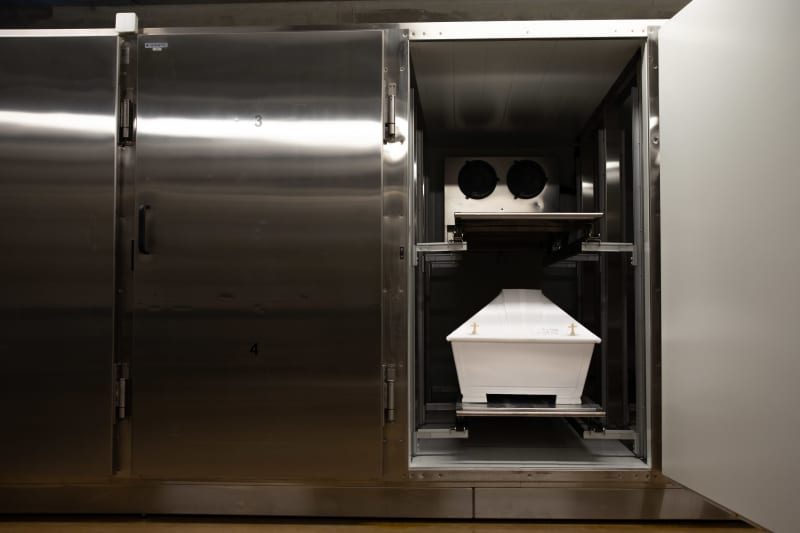At the turn of October and November, death is present during various holidays. Many current traditions are based on religious and even ancient pagan beliefs.
The deceased, dressed in white, sleeps in a decorated coffin on a mattress, head on a pillow, waiting to go to heaven.
A tradition that has changed very little in Finnish society in 300-400 years – despite the fact that more and more Finns choose to be cremated or do not belong to a church.
The deceased’s white clothes represent the Christian sky and clouds, while the decorated coffin represents the bed.
– The coffin has been the place where the deceased has waited for the resurrection, Lipkin says.
Dressing the deceased has a long historical tradition
According to the researcher, in the 17th century, the clothes of the deceased had some other colors, but since the 18th century, the color has mostly been white.
Nowadays, the deceased can be dressed in his own clothes, but the selection of clothes offered by undertakers is still completely white.
However, no one is sent on their last journey without clothes.
– The idea of \u200b\u200bthe deceased being naked in a coffin is foreign. It has a very long historical tradition.
According to Lipkin, the dead have been clothed long before Christianity spread to Finland. The background has been fear and respect for death.
– If the deceased had too few clothes in the coffin, it was thought that he might get restless and get up from there to demand clothes from his relatives because he is cold. These stories were told so that the dead would be dressed respectfully and well.
The clothes were used to ensure that the deceased was comfortable. Lipkin says that the deceased was usually dressed by an older woman who was not afraid of death.
– At least this is what the historical sources say. A person with a certain way of thinking was needed for that task.
Before that, around the 11th century, Finnish dead were dressed very differently than in the Christian era, based on archaeological findings.
– A bear tree was placed at the bottom of the wooden coffin, and people were buried in their best party clothes. Just in the kind of decorative clothes that have probably been used during their lives, says Lipkin.
The dead have been buried and cremated over the millennia
The earliest graves found in Finland are from the Stone Age 8,000 years ago. The Stone Age prevailed in the years 8,600–1,500 before the beginning of the chronology (bc).
According to Lipkin, in the Stone Age burials dug into the ground, traces of the use of red soil and stone and amber jewelry have been found, as the earthly remains have long since disappeared in Finland’s acidic soil.
In the Bronze Age 1700–500 BC. the deceased were buried both as a cremation and as a cremation in stone mounds.
According to Lipkin, coffin burials have been done since at least the Iron Age. The Iron Age in Finland dates from 500 BC to 1,300 AD.
At that time, coffins were carved into large tree trunks, inside which the deceased were placed. The dead were also burned in the Iron Age.
– Crematorium cemeteries have been found, for example, in Ii and Valmarinniemi in Keminmaa, Lipkin says.
When Christianity began to spread to Finland, burials became more common. The dead were buried around the church in the churchyard and under the church floor.
When the belief in miasma, i.e. bad smells that spread diseases, spread from Europe to Finland, the dead buried under the church were considered dangerous. The smell was especially bad in summer.
The discussion about the safety of the situation led to the fact that cemeteries separate from churchyards began to be placed outside the cities from the 18th century.
It is believed that spirits will soon roam the earth
Halloween is celebrated on the last day of October, or All Saints’ Eve. Since the day falls on a Monday this year, many people may celebrate the feast of ghosts already at the weekend.
The roots of the children’s festival, which landed in Finland from the United States, go back to the Celtic New Year’s Day Samhain and the harvest festival, when the dead were believed to be on the move.
Next week, Spain and Central and South America also celebrate the Day of the Dead, and a week later All Saints’ Day in Finland. The purpose of both holidays is to remember the dead.
– Although there are big differences in the customs of different cultures, the ultimate ideas about remembering and honoring the dead are very similar, Sanna Lipkin points out.
In Finland, the dead are often remembered by taking a candle to the grave. According to the researcher, the habit is especially important for Finns.
He does not believe that Halloween will replace Finnish tradition. For children, it is still more and more important every year.
Death is present in both holidays, although in different ways.
– No single person is remembered on Halloween. It’s more of a deterrent, a game. One way for children to deal with difficult issues is through play, states Lipkin.
*What thoughts does the story evoke? You can discuss the topic on 30.10. until 11 p.m.*

